Mary Help of Christians
Mary, the Help of Christians (Latin: Sancta Maria Auxiliatricis Christianorum), is a Roman Catholic title of the Blessed Virgin Mary, based on a religious devotion now associated with a feast day of the General Roman Calendar on 24 May.

The Catholic saint, John Chrysostom, was the first person to use this Marian title in year 345 AD. Both Don Bosco and Maria Domenica Mazzarello also propagated the same piety and devotion.
Pope Pius V invoked the Christian army of the Holy League in 1571 and its victory achieved was consequently attributed to the intercession of Mary under this devotional title during the expansion of the Islamic Ottoman Empire intended to invade Christian Europe.
Pope Pius IX granted the first decree of pontifical coronation to the venerated Marian image enshrined within the Basilique Notre-Dame de Bonsecours on 15 July 1870. The Archbishop of Rouen, Cardinal Henri-Marie-Gaston Boisnormand de Bonnechose executed the rite of coronation on 24 May 1880.
Pope Leo XIII consequently signed and granted a pontifical decree of canonical coronation towards the Turin image on 13 February 1903. The rite of coronation was executed on 17 May 1903 by the former Archbishop of Turin, Cardinal Agostino Richelmy. Pope Pius X raised the namesake shrine to the status of Minor Basilica via his Pontifical decree Anno Reparatæ Salutis on 12 July 1911.
The title is also venerated by the Society of Mary (Anglican) who belong to the Church of England.
History
| Part of a series on the |
| Mariology of the Catholic Church |
|---|
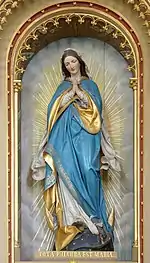 |
|
|
Patristic origins
There are two inscriptions from the first centuries of Christianity in Greek related to Mary: θεοτοκος (Teotokos, Theotokos, Mother of God) and βοηθεια (Boetheia, the Helper). The Fathers of the Church referred to Mary as "βοηθεια". John Chrysostom used the title in a homily of 345, Proclus in 476 and Sebas of Caesarea in 532. After the Patristic period (5th century), other notable Christian patriarchs used it like Romanos the Melodist in the year 518, the Patriarch of Jerusalem, Sophronius in 560, John of Damascus in 749 and Germanus I of Constantinople in 733.
The Litany of Loreto
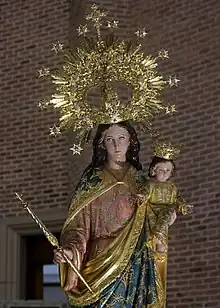
In 1576, the Archpriest of Loreto, Bernardino Cirillo published at Macerata two litanies of the Blessed Virgin, which he contended, were used at Loreto. One is in a form entirely different from the present text, while another form, “Aliæ Litaniæ Beatæ Maria Virginis”, is identical to the litany approved by Pope Clement VIII in 1601 and now used throughout the Church. This second form contains the invocation Auxilium Christianorum warriors returning from the Battle of Lepanto (7 October 1571) visited the Loreto, and saluted the Holy Virgin there for the first time with this title. It is more probable, however, that it is a variation of the older invocation Advocata Christianorum, found in a litany of 1524.[1]
The first surviving translation of this litany, yet still incomplete, in the Spanish language was recorded in 1621 under the title La Letania Sagrada de la Bienaventurada Virgen Maria in Valladolid, Spain.
The Italian religious author Orazio (Horatio) Torsellini (1597) and the Roman Breviary (May 24, Appendix) claim that Pope Pius V inserted the invocation in the Litany of Loreto after the Battle of Lepanto. The form of the litany in which it is first found, however, was unknown at Rome at the time of Pope Pius V. [2]
Marian Feast
The feast of Our Lady, Help of Christians, was instituted by Pope Pius VII. By order of Napoleon I of France, Pope Pius VII was arrested on 5 June 1808, and detained a prisoner first at Grenoble, and then at Fontainebleau.[3] In January 1814, after the battle of Leipzig, he was brought back to Savona and set free on 17 March, on the eve of the feast of Our Lady of Mercy, the Patroness of Savona. The journey to Rome was a veritable triumphal march. The Pope, attributing the victory of the church after so much agony and distress to the Blessed Virgin, visited many of her sanctuaries on the way and crowned her images (e.g., the "Madonna del Monte" at Cesena, "della Misericordia" at Treja, "della Colonne" and "della Tempestà" at Tolentino). The people crowded the streets to catch a glimpse of the Pope who had withstood the threats of Napoleon. He entered Rome on 24 May 1814, and was enthusiastically welcomed.[4] To commemorate his own sufferings and those of the church during his exile Pope Pius VII extended the feast of the Seven Dolours of Mary to the Catholic Church on 18 September 1814.
When Napoleon left Elba and returned to Paris, Murat was about to march through the Papal States from Naples; Pius VII fled to Savona 22 March 1815.[1] After the Congress of Vienna and the battle of Waterloo, the Pope returned to Rome on 7 July 1815. To give thanks to God and Our Lady, on 15 September 1815 he declared 24 May, the anniversary of his first return, to be henceforth the feast of Our Lady, Help of Christians. The 1913 Catholic Encyclopaedia article commented that "it has spread nearly over the entire Latin Church, but is not contained in the universal calendar."
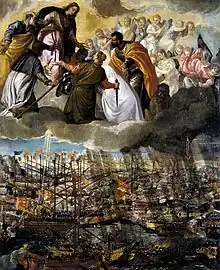
The Marian feast has been celebrated by the Order of Servites since the 17th century. The veneration to Mary became popular under this title in Rome especially, where the feast was especially promoted by John Bosco and Vincent Pallotti.[5] Bosco was an ardent promoter of devotion to "Mary, Help of Christians". He built a huge basilica in her honour in 1868 and founded a religious congregation for women, under the title of, "The Daughters of Mary, Help of Christians". Interpreting the painting he had commissioned for the basilica, Bosco referred to it as depicting Mary Mother of the Church.
The Second Vatican Council in the Constitution on the Church (Section # 61, 62) cites this Marian title and states the following:
In an utterly singular way she co-operated by her obedience, faith, hope and burning charity in the Saviour's work of restoring supernatural life to souls. For this reason she is a mother to us in the order of grace…By her maternal charity, Mary cares for the brethren of her Son who still wander through this world in the midst of dangers and difficulties until they are led to the happiness of their heavenly home".[6]
Observance
The church has traditionally focused on two aspects of Our Lady's help on this feast day. Firstly, the church focuses in this feast on the role of Our Lady's intercession in the fight against sin in the life of a believer. Secondly, the church focuses on Our Lady as one who assists Christians as a community, through her intercession, in fighting against anti-Christian forces.
Michael Daniel observes that, while this approach may be regarded as outdated, in light of Vatican II, where the world and non-Christians elements therein were seen in a positive rather than a hostile or threatening light, it would seem that it would be naïve on the part of Christians to regard all movements and all social trends as either good or harmless.[6]
The dioceses of Tuscany adopted it on 12 February 1816. The hymns of the Office were composed by Brandimarte.[7]
It became the patronal feast of Australasia, a double of the first class with an octave.[8] After the reforms of the Second Vatican Council, it was designated a solemnity to be kept on the first available Sunday on or after 24 May.
The Fathers of the Foreign Missions of Paris, in accordance with a vow (1891), celebrated this feast with great splendor in their churches.
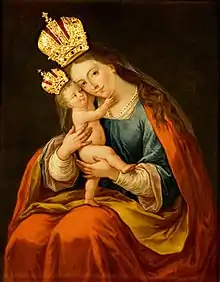
It has attained special renown since John Bosco, founder of the Salesian Congregation, dedicated his foundation to Our Lady, Help of Christians, the mother church of his congregation at Turin on 9 June 1868. The Salesians have carried the devotion to their numerous establishments. It was established due to the great appreciation of Don Bosco for this Marian title and the development of the Salesian works in many countries since the second half of the 19th century. The Salesian National Shrine of Our Lady Help of Christians is located in Stony Point, New York. There is also the National Shrine of Mary Help of Christians in Parañaque City, Philippines, which is also in the care of the Salesians of Don Bosco. [9]
In memory of the liberation of Pope Pius VII from the captivation and imprisonment of Lord Napoleon Bonaparte, which the Pope credited to be by supernatural assistance, the following congregations honored the Blessed Virgin Mary under this title:
- The Diocese of Australia, by institution of an Octave (1888)
- The Order of Barnabites (1908)
- The Society of the Divine Savior (1909)
- The Society of Saint Francis de Sales (1910)
- In the Diocese of La Serena, Chile (1914)
- In the Diocese of Skopje, North Macedonia (1914)
The Church of Notre Dame du Bon Secours in Blosseville, France was also inaugurated under this Marian title “Help of Christians”, dating back to the original church structure in the 13th century. It was finalized in 1840 and Pope Benedict XV ultimately granted a pontifical decree that raised the shrine to the status of minor basilica on 27 March 1919.
The Abbey of Mary Help of Christians, better known as Belmont Abbey, is a small American monastery of Benedictine monks in the town of Belmont, Gaston County, North Carolina, outside of Charlotte, North Carolina. The minor basilica of Our Lady Help of Christians is listed on the National Register of Historic Places.[10]
A chapel dedicated to this namesake Marian title exists at the Basilica of the Immaculate Conception in Washington, D.C., America. [11]
Under this title, the Virgin Mary is venerated by the Chinese Catholics, particularly at the Shrine of our Lady of Sheshan, the only minor papal basilica in mainland China. In May 2007, Pope Benedict XVI designated 24 May her feast for the Catholics in China, who face persecution and restriction from the Chinese Communist Party.
Although it is commonly associated with the Catholic Church, the Eastern Orthodox Church has also known the devotion since 1030 in Ukraine, when the country was defended from a barbarian invasion.
Pontifical approbations
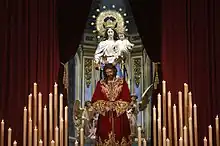
- Pope Pius V — exhorted intercessory prayers to Mary under this devotional title in 7 October 1571 during the invasion of the Battle of Lepanto, by which he made an addendum to the Litany of Loreto with this Marian title. Originally a Marian feast instituted under the title of "Our Lady of Victory", it was later changed to the "Feast of the Holy Rosary" by his successor Pope Gregory XIII for the month of "October" in 1573 which survives until this day.
- Pope Pius VII — honored the Virgin Mary under this title upon his release from imprisonment by Lord Napoleon Bonaparte on 24 May 1814, by which he formally instituted the feast of the Virgin Mary under this specific title and survives until present time.
- Pope Pius IX — issued the following decrees:
- Granted a pontifical decree to the Sacred Congregation of Rites of this Marian title as the official patroness of Australia in 1852. Cardinal Francis Moran expanded this with the institution of an Octave feast for the Diocese of Sydney in 1888.[12]
- Granted a decree of pontifical coronation to a Marian image of Notre Dame du Bon Secours, Marie Auxiliatrice on 15 July 1870, now enshrined at the Basilique Notre-Dame de Bonsecours in Rouen, France.
- Pope Leo XIII — issued the following decrees:
- Granted a congratulatory decree on 19 December 1884 to the Priory of Saint Mary Help of Christians in the United States, raising it from a priory to an Abbey under the official patronage of the namesake Marian title.
- Granted a pontifical decree of canonical coronation to the famed Turin image on 13 February 1903 through his papal legate, Cardinal Agostino Richelmy, who crowned it on 17 May 1903.
- Pope Pius X — issued the following Pontifical decrees:
- Granted a decree of pontifical coronation for the venerated Marian painting at the Basilica in Brezje, Radovljica, Slovenia, on 24 June 1907 and was crowned on 1 September of the same year.
- Raised the shrine of the Basilica of Our Lady Help of Christians, Turin to the status of Minor Basilica via the Pontifical decree Anno Reparatæ Salutis on 12 July 1911.
- Pope Benedict XV — issued the following decrees:
- Re—declared this patronage for Australia with a congratulatory decree titled In Cœtu Sodalium granted to the Master General of the Dominican Order Ludwig Maria von Theissling under the honorific title of "Old Virgin / Ancient Virgin" on 29 October 1916.
- Raised the Marian namesake shrine in Rouen, France to the status of Minor Basilica by his Pontifical decree Illustriores Inter Sacras on 27 March 1919.
- Pope Pius XI — granted the creation of the Parish of Santa Maria Ausiliatrice, Rome on 25 March 1932 via the decree Inter Pastoralis which was entrusted to the Order of the Salesians of Don Bosco.
- Pope Pius XII — issued the following decrees:
- Raised the namesake Shrine in Buenos Aires, Argentina to the status of Minor Basilica via the decree Bonærense Templum on 12 June 1942.
- Formally elevated the Mary Help of Christians shrine in Shanghai, China to the status of Minor Basilica (written on 24 July 1942) and officially signed and notarized on 12 September 1942 via his pontifical decree Compertum Habemus.
- Granted a Pontifical decree Sacras Inter Ædes on 12 September 1950 raising the shrine of the namesake image to the status of Minor Basilica in Niteroi, Brazil, notarized by the Regent of Apostolic Briefs, Monsignor Gildo Brugnola.
- Issued a Pontifical decree Perfugium Rebus redeclaring the namesake Marian title as Patron (with Pope Leo I) of the Territorial Abbey of Belmont on 5 December 1957.
- Pope John XXIII — granted the following decrees:
- Issued a pontifical decree Auxiliatricem Virginem granting the namesake Marian title as patroness of Viedma, Argentina signed and notarized by Cardinal Domenico Tardini on 19 April 1960.
- Raised the namesake shrine to the status of minor basilica via the decree In Peculiare Decus located in Lima, Peru on 25 March 1962.
- Pope Paul VI — funded the crown and scepter of the namesake image within the high altar of Santa Maria Ausiliatrice, Rome (Tusculana) which he blessed on 5 December 1965 to close the Second Vatican Council.
- He later decreed the shrine as a Titular church 7 June 1967 via the Apostolic Constitution Ad Gubernacula Christianæ. The same Pontiff later raised this shrine to the status of Minor Basilica via the Pontifical Decree Dulcia Christi Verba on 1 April 1969.
- Pope John Paul II — granted the following pontifical decrees:
- Raised the sanctuary of Mary Help of Christians to the status of Minor Basilica in Brezje, Radovljica, Slovenia, via formal decree titled Satis Quidem Constat on 5 October 1988.
- Decree of canonical coronation titled In Ecclesia Sanctuario for a namesake image in Twardogóra, Poland, on 5 May 1994 and was crowned on 24 September 1995.[13]
- Raised the namesake shrine of Belmont Abbey, North Carolina in the United States to the status of Minor basilica via the decree Sacras Ædes on 27 July 1998.
- Pope Benedict XVI — honored Mary under this title via the following pontifical decrees:
- Raised the shrine of Holy Hill National Shrine of Mary, Help of Christians in Wisconsin to the status of Minor Basilica via Pontifical decree on 11 July 2006.
- Granted a decree of pontifical coronation for a namesake image in Cordoba, Spain signed on 2 April 2008, later crowned on 10 May 2009.
- Raised the sanctuary with the namesake Marian title to the status of Minor Basilica in Seville, Spain signed on 26 October 2008.
- During his Regina Caeli papal address invoked this Marian patronage, under the venerated title of Our Mother of Sheshan, calling for Chinese Catholics to renew their fidelity to the pope as the sole successor of Peter in 24 May 2009.[14]
- Pope Francis — granted two decrees of canonical coronation of namesake images for the Philippines.
- The first image is enshrined in the "Catholic Theological Seminary" in San Fabian, Pangasinan on 23 March 2018. The image was crowned on 22 August 2018. This image was a gift to the Philippine Islands by the apostolic delegate, Guglielmo Piani.
- The second image granted another decree on 16 November 2021 was for the namesake image in Parañaque City. The image was officially crowned on 24 May 2022 and dates back to the Second World War.
Artistic representations
 Mariahilf. Lucas Cranach the Elder, c. 1520, Cathedral of St. Jakob in Innsbruck
Mariahilf. Lucas Cranach the Elder, c. 1520, Cathedral of St. Jakob in Innsbruck Image of Our Lady of Sheshan, Help of Christians as it appears atop the exterior cupola of the Sheshan Basilica, this rendition above is created by Holy Wisdom Catholic Decoration and Art Design Studio(圣智天主教装饰与艺术品工作室) in Shanghai
Image of Our Lady of Sheshan, Help of Christians as it appears atop the exterior cupola of the Sheshan Basilica, this rendition above is created by Holy Wisdom Catholic Decoration and Art Design Studio(圣智天主教装饰与艺术品工作室) in Shanghai Statue at the shrine of Our Lady Help of Christians, in Miguel Hidalgo of Federal District, Mexico
Statue at the shrine of Our Lady Help of Christians, in Miguel Hidalgo of Federal District, Mexico Altar at Mariahilf church Vienna
Altar at Mariahilf church Vienna 18th-century painting at Matzleinsdorf church, Austria
18th-century painting at Matzleinsdorf church, Austria The Marian image with crown and scepter blessed by Pope Paul VI in the Basilica of Tuscolana in 5 December 1965.
The Marian image with crown and scepter blessed by Pope Paul VI in the Basilica of Tuscolana in 5 December 1965.
See also
References
- Holweck, Frederick. "Feast of Our Lady, Help of Christians." The Catholic Encyclopedia. Vol. 11. New York: Robert Appleton Company, 1911. 9 Mar. 2013
- See LITANY OF LORETO; Schuetz, "Gesch. des Rosenkranzgebets", Paderborn, 1909, 243 sq.
- "Mary Help of Christians", Catholic News Agency
- McCaffrey, "History of the Catholic Church in the Nineteenth Cent.", 1909, I, 52
- Remigius Bäumer et al. Marienlexikon 1994, p. 533
- Daniel, Michael. "Our Lady Help of Christians"
- Chevalier, "Repert. Hymnolog.", II, 495
- Ordo Australasiae, 1888
- National Shrine of Our Lady Help of Christians
- Basilica of Mary, Help of Christians
- Chapel of Our Lady Help of Christians, Basilica of the Immaculate Conception, Washington D.C.
- "Mary Help of Christians", Salesian Sisters of St. John Bosco
- "In ecclesia sanctuario - Littera apostolica | Ioannes Paulus II".
- Benedict XVI. Church in China, renew your fidelity to Peter on YouTube
.jpg.webp)